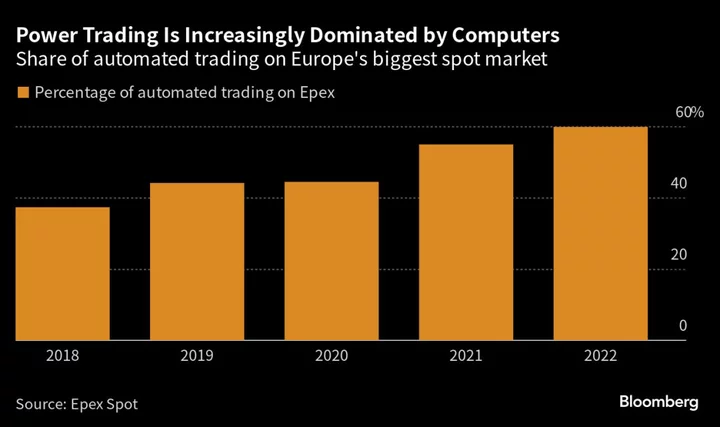A Danish energy trader crunches about 30 million data points every day in an effort to predict how cloud cover in Spain and surging temperatures in Germany might ripple across to impact the price of power in France and elsewhere in Europe.
In the region’s €1.3 trillion electricity market, MFT Energy A/S and more than a dozen other trading houses are increasingly embracing artificial intelligence and machine learning to make money — and in the process help set prices ultimately paid by households and businesses.
Nearly half of MFT’s electricity trades last year were done by algorithms, and the trend is on the rise. At Epex Spot SE in Paris, Europe’s biggest exchange for short-term trading, automated deals accounted for as much as 60% of transactions last year, up from 55% in 2021.
Algorithmic trading is “really going to be a requirement to keep a competitive edge,” said Brad Blesie, chief investment officer at Trailstone Group, which uses AI to manage renewable assets, forecast weather and predict price levels. “It’s hard, but we really do think that there’s huge scope.”
The effort has taken on greater urgency as the continent ramps up its reliance on intermittent renewable energy. Supply can swing wildly if clouds settle over solar farms or gusts sweep in off the Atlantic. In Germany, electricity prices tumbled to a record of negative €500 per megawatt-hour briefly in the afternoon, when a surge in solar power overwhelmed weekend demand earlier this month.
Read More: UK Power Traders Will Be Banned From Charging Excessive Prices
That type of volatility and the massive amount of data needed to track supply and demand opens up lucrative opportunities for traders savvy enough to harness satellite images, weather patterns and even social media posts to get ahead of price changes.
Energy traders are part of the complex interconnections that keep Europe’s power network operating. They help keep the grid balanced by shifting power to where it’s most needed — and earn a margin by getting ahead of the market. Volatility like during last year’s energy crisis is a good thing for these companies, and MFT’s 2022 profit surged more than eightfold to €576 million ($627 million) — about €4.4 million per employee.
But the automated systems aren’t perfect. During Germany’s solar surge, human traders needed to take on a bigger role managing a situation that was too complex to leave entirely to software programs.
“It is fair to say that less algorithms will be used on these very extreme, first-in-history days,” said Tim Kummerfeld, head of intra-day trading at Danske Commodities A/S. But even in such scenarios “algorithms will still contribute to providing liquidity and dampen price volatility.”
The Danish firm made profit of €2.25 billion last year, surging from €265 million in 2021, as electricity and gas prices spiked.
While robo-trading happens across all kinds of markets from stocks and bonds to oil and metals, the amount of data around supply, demand and infrastructure is what sets the electricity market apart — especially in Europe where interconnectors between national grids create bottlenecks. Even in emergencies — when power outages hang in the balance — computers are likely to play an increasing role over time.
“The nice thing about algos is that they also learn based on training data,” Danske’s Kummerfeld said. “So the next time the market clears so low, there will probably be more algorithmic activity.”
The most advanced traders dig into unstructured data — information that’s not readily digestible or understood by normal systems. That includes text in multiple languages, images, financial reports from places that don’t use international accounting standards and even anecdotes.
The traders at MFT get nuggets of information via interfaces on more than a dozen screens on their desks. The signals come in as graphics, numbers or simple text. It can be direct trade ideas or indications of a brewing supply issue somewhere in Europe.
In Germany, the market moves so quickly that human traders in most cases can’t keep up, for example with changes in cloud cover. With the nation planning to increase solar capacity from about 68 gigawatts to more than 200 gigawatts by the end of the decade, spotting such changes will be even more vital.
In the last five years, the number of order submissions across Epex’s intraday markets have jumped to over 7 million a day from less than 1 million, according to data from the exchange.
At MFT, data models create more than 1,300 trade signals daily. Trading is more than ever a game of understanding data and its impact on the markets, said Jacob Guldberg, the firm’s vice president of algorithmic trading.
But there’s no replacing human knowledge and experience. Traders will still have to work with and finetune the computer models.
“You still need a deep understanding of the market to fully utilize them,” Guldberg said.

